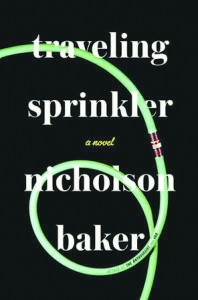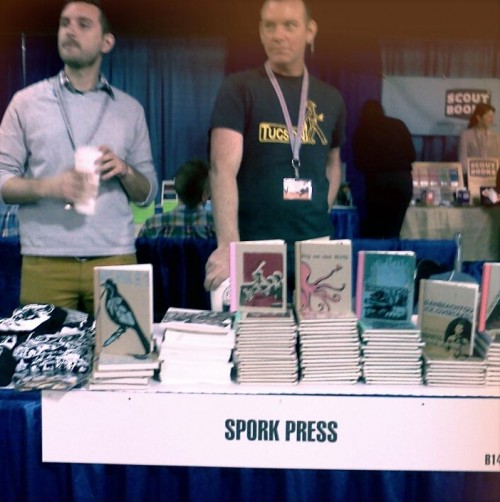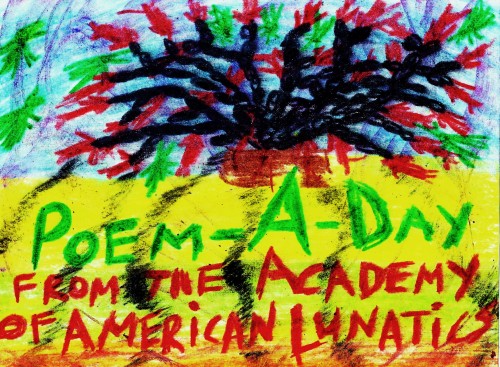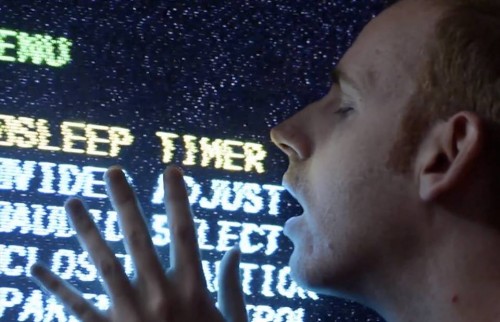POEM-A-DAY from THE ACADEMY OF AMERICAN LUNATICS (#6)

Danielle Pafunda resists the day’s terms even as she’s complicit in and bound to them, to carry them out. The children are calling that Playmobil cop Uncle Shootser, again. She’s taking unflattering pictures, no, she means just actual pictures of her navel while she reads Elisabeth Bronfen.
Your Conscript
by Danielle Pafunda
Get the fuck away from me. I’m sick and free.
I’ve puked my heart out and also my other organs.
My liver spills, my kidneys spilled, my blood
turns the color of a nuclear sunset and hums across
the spoiled garden path. I’ve been at these stones
with a shotgun. I’ve been nailing the doors shut.
In any event, I drowned your book in the river.
At the river, two large men grabbed my arms
and pinned me against a shipping container.
They tore your words out of my throat and held them
in the pink arc cast by a security light. Give him up
they told me, and I did. Over and over again
retching into their outstretched sack, retching
money and grief and the look of your hair
plastered down by an oily rain.
![]()
 When I first ate that rat after I first regurgitated that rat (see Johannes) and wouldn’t you know that rat was high on cocaine and babies (see Scientific American January 2006) I had the tongue of a songbird stitched into my tongue (see Chelsea Biondolillo, see Katrina Van Gouw, see Philomela). A blank spot on my tongue. A salt scar on my tongue. I only speak English. I make a high-pitched whinny at which babies coo (see babies). I can identify tone. You have your search terms.
When I first ate that rat after I first regurgitated that rat (see Johannes) and wouldn’t you know that rat was high on cocaine and babies (see Scientific American January 2006) I had the tongue of a songbird stitched into my tongue (see Chelsea Biondolillo, see Katrina Van Gouw, see Philomela). A blank spot on my tongue. A salt scar on my tongue. I only speak English. I make a high-pitched whinny at which babies coo (see babies). I can identify tone. You have your search terms.
note: I’ve started this feature up as a kind of homage and alternative (a companion series, if you will) to the incredible work Alex Dimitrov and the rest of the team at the The Academy of American Poets are doing. I mean it’s astonishing how they are able to get masterpieces of such stature out to the masses on an almost daily basis. But, some poems, though formidable in their own right, aren’t quite right for that pantheon. And, so I’m planning on bridging the gap. A kind of complementary series. Enjoy!
November 23rd, 2013 / 9:34 pm
“It must be good to run / the show like that.”
 If this relationship is going to work—and no one really cares if it does; I mean, ships have jobs; relations are just the second attempt at lations—you’re going to have to accept the fact I’m going to post about some new issue of an online magazine when it rains.
If this relationship is going to work—and no one really cares if it does; I mean, ships have jobs; relations are just the second attempt at lations—you’re going to have to accept the fact I’m going to post about some new issue of an online magazine when it rains.
This time around it’s Wag’s Revue, and specifically in Wag’s Revue the rompy and potluck-ish poems of Rachael Katz and the Grace-Paleyish-wise-laughing-at-how-many-generic-varieties-of-Lemon-Pledge-exist-in-our-hearts story called “Palmistry for the Modern Age” by Hannah Pass.
Though I’m not normally a fan of faking book technology online, I think I like the navigation of Wag’s Revue—though I wish the fake-page-box were a little bigger and the font weight wasn’t so extreme. But the editors say they are working on a site redesign, and I am really interested in how declarative the reading experience is. Like it’s very “hark! this is how you shall read.” Which seems against the stream in a way I respect, like when you touch your friend’s antique record player and they snap at you “that’s not for touching!” And you’re like, damn, I respect that.
Respect for yourself by reading Rachael Katz’s “You Girls Are,” which I’m going to go ahead and call the best new ode I’ve read in months of leaves.
Nicholson Baker’s The Traveling Sprinkler
 The Traveling Sprinkler
The Traveling Sprinkler
by Nicholson Baker
Blue Rider Press, Sept 2013
304 pages / $24.85 Buy from Amazon
Before we begin the review proper, an interesting parallel.
Nicholson Baker, in his 2011 Paris Review interview, on the writing of The Mezzanine: “It was totally absorbing, the feeling of being sunk in the midst of a big, warm, almost unmanageable pond. I could sense all these notes I had, all these observations I’d saved up to use, finally arranging themselves in relation to one other.”
Paul Chowder, Baker’s protagonist in The Traveling Sprinkler, quoting Claude Debussy answering a question about his compositional process: “Gradually after these thoughts have simmered for a certain length of time music begins to centre around them, and I feel that I must give expression to the harmonies which haunt me.”
Chowder, again, quoting Freud, “There are no coincidences.”
We first met the middle-aged poet Paul Chowder in 2010’s The Anthologist, as he attempted to write an introduction to a poetry anthology while navigating myriad distractions, from his lost lady love to the wealth of poetic knowledge residing within his own head. He was Baker by proxy, the writer of dirty books laid bare as an astute intellectual who has money and love problems, copious idiosyncrasies, and who just happens to have a masterful knack for nicknaming male genitalia (“Shropshire lad” being a particularly outstanding one this time around).
For The Anthologist, Baker recorded himself in various locations talking into a camera, attempting to be honest and naked in a way that writers often refuse to be behind the carefully composed written word. Honesty in writing, after all, is always edited, and has the benefit of a first draft.
Similarly, The Traveling Sprinkler, made heavy use of audio recordings, self-interviews, that were later transcribed and tinkered with and embellished into the continued adventures of Paul Chowder, who now finds himself owing a new book of poetry to his faithful publisher, who has now quit drinking Yukon Jack in the meantime, who wants to learn the guitar, who can only seem to write when parked in the shade in his Kia, who has once again lost Roz.
While The Anthologist was very much a book about poetry (well, among other things), this book chronicles our narrator’s love affair with music, from his early years as a promising bassoonist (a career path that was derailed by a basketball accident), to his new obsession with both singer-songwriters and modern dance music. Underworld is namedropped, Debussy’s “The Sunken Cathedral” is dissected in an out, and YouTube URLs to college students singing protest songs awkwardly conclude paragraphs left wanting for proper final punctuation. The only thing missing is an official Traveling Sprinkler Spotify playlist. Excuse me while I make one.
Are there any critics of serious literature remaining that vehemently oppose the appearance of modernisms in novels? If so, poor things, keep them away from The Traveling Sprinkler.
The line between Baker and Chowder is once again thin, if not opaque, but, like the book’s namesake Sears product, winds along in anything but a straight line. It can, admittedly, be distracting, as someone who obsesses over the biographical details of authors, to have to pause and wonder if what you’re reading is really how Nicholson Baker really feels about dance music or drones or climate change or even peanut butter crackers. When we read an obviously fictitious novel, we’re free to get swept away, but with Baker so close under the surface, we want him to be the one talking to us. This may, admittedly, be a hang-up limited to serious enthusiasts, and that particular longing shouldn’t be mistaken for critique.
What Baker has accomplished here is to give us, along with late-period David Markson, the best look into the writer’s brain, one that no Paris Review interview could even begin to reveal. More specifically, the aging writer, the one who no longer voraciously reads, and whose head is full of facts and knowledge, but who faces the very real possibility that the well might be dry and all that is left to do is a sort of self-inventory for posterity. The secret is, of course, that writers of all ages are doing just that, perhaps dressed up in a grand narrative or imaginative forms, but that nonetheless. Just ask the 31-year-old that wrote The Mezzanine.
The parallel with Markson is an interesting one, as Paul Chowder admits to never having been able to read novels, while Markson admitted (both in interviews and later by way of his own thinly guised fictional protagonist) to having run out of drive to read them, and that with five of his own still to come. Both writers eventually stumbled upon a groove in which they became literal anthologists of the contents of their minds, Markson right up until he died.
In an all-to-brief and somewhat stilted interview on The Colbert Report, Baker likened the traveling sprinkler to us, navigating the garden of our minds. I’m not sure there exists a more perfect, if idiosyncratic, metaphor for writing, although what force it is that pulls us along is still up for debate. Regardless of your answer, it’s worth celebrating that Nicholson Baker still has plenty of hose left.
***
James J. Fitze is a writer and editor living in New York City. A music journalist “in a past life,” James currently contributes to a living novel at thedownmachine.com.
November 22nd, 2013 / 11:00 am
The Fata Morgana Books by Jonathan Littell
 The Fata Morgana Books
The Fata Morgana Books
by Jonathan Littell
Translated by Charlotte Mandell
Two Lines Press, Nov 2013
208 pages / $14.95 Buy from Two Lines Press or Amazon
The four novellas that comprise this collection deal with a wealth of themes, but the ultimate one is of unachieved desire and the isolating mania it spawns. Instead of the narrators (or perhaps they’re all the same person in each story) dealing with crushing let downs internally, the reality surrounding them alters into hellish distortions of traverses through time and space. ‘Surrealistic’ doesn’t fully capture the formal breed of this collection, but each reader still gets pressured into a position of abstract meaning-making. Each first-person protagonist comes across as calm, numb, accepting, and apathetic toward the edge of reality they skate on through these sparse stories. From one novella to another, though, a sense of personal progression exists through the environments the narrators find themselves in. Yet each setting is coated with a muffled insistence on the pointlessness of these progressions.
The first novella, Etudes, is a solitary study of man unafraid of the warzone he’s captured in, yet terrified of acting on his desires toward his woman of interest. These unmet desires move the narrator to more accessible perversions, which morph playful and genuine aspects of interaction into ones of horror. The objects of his affection alternate through the four sections of this story, but his own timidity of intimacy begins to create external barriers that increasingly prevent him from even being in the presence of the woman he wants. “My despondency was so profound that I was only barely aware of the appalling comedy of the situation,” he recounts after a flight delay makes it impossible to share a plane ride with his current obsession. The final section, however, shows the narrator as an emotionally sapped and mechanical being, going through motions that prevent him from fully dealing with his past failures.
Story About Nothing is a free flowing narration of negation. Its dreamlike uncertainty weaves through the inner sensual life of a man who defies his masculinity by wearing women’s clothing beneath his socially accepted guise. Human motion plays a large role in this story, from his description of pornography that paralyzes his eyes and attention in awe (“these images remained what they were, frozen in the eternal repetition of their so violently human perfection”) to the motions of dancing women, and the process of his drunkenness alike as “a form of communion, the step beyond that imperceptibly opens up the road to the world of death, revealing to the one taking it that it already stretches far behind him, and always has.” In the end, it’s a sweet story about bitter life, contradicting itself into nothingness.
The two stories previous to In Quarters had narrators with a sense of character, while the latter two increase the numbness and alienation. In Etudes, characters had letter names (A., B., C., etc.); in this third story, a dismissive identification—as if all children and all adults were some abstract conglomeration of otherness—is all that exists:
Isolation engulfs the narrator here as a permanent fact of life. No joy can be experienced like the playing and laughing children that form the background of a scene, only the annoyance of their interrupting his reading. The images that float before him begin to meld despite their disharmony, going from a soldier chopping off a prisoner’s head to a naked girl brushing her teeth right in front of him completely seamlessly. In abstraction his isolation grows stronger. Through symbolic Adam and Eve interpretations he starts to instinctually distance himself even further from the woman who wants closeness with him, and the comfortable family life he’s surrounded by seems only a loosely guarded microcosm with ready potential for fear to penetrate and crumble it.
The last and longest story, An Old Story, begins with our narrator emerging from the water, like the progression of narrators throughout all of these stories ascending to the numb surface of isolated reality from their past dawdlings beneath, in their own interior full of fearful romanticizings. The deeper into this collection of stories we go, the less frequently paragraphs breaks exist, and by this final story all of life becomes something akin to a no-rest endurance test. Different permutations of fucking and being fucked get explored through these large blocks of text, along with tilting perspectives on dominance, submissiveness, masculinity, and femininity. Any sense of normal life begins to dissolve once we enter into a hallucinatory orgy scene, where, in the grip of complete unreality, terror immediately pervades. By enacting his own perversions into active reality, our narrator leaps from simple indulgence to becoming a prisoner of his own imaginative desires yet again, and jumps back into the water. When he comes back up in the second section, all of life still seems foreign to him, like someone else’s imagination in action. Former memories get mixed up and forgotten as he cuts apart figures in photographs, rearranges them, and tucks them away in the confines of his pocket. A prostitute who he frequented, but couldn’t remember, beats him up and eventually he trips into an underground gay sex club that turns into his own personal army, an army that eventually wanders around raping and pillaging. Any remaining desires of equality and comfort get fully eradicated by our narrator as he continues to move forward and finally accepts that all of life is eternal conflict.
November 22nd, 2013 / 11:00 am
NEKKID & NEUROTIC
Interesting piece on the Romantik of the 70s. Reference-heavy, but mostly familiar texts & media, I think.
Also, click on the second footnote’s link to read the Eno thing: Naked and Neurotic. It’s kinda wild/ weird: “The only time my feet aren’t cold is when I make love, which I do all the time. I only make love to keep my feet warm.”
“Why The Hell Wouldn’t I?”– (Talking to Evan J. Peterson)
Rauan: When we chatted in person you mentioned that a big part of your outrageous onstage persona is a pushback against over-serious readers (performers of their own poetry, I mean) who, as you said, have absolute “no sense of humor.” Can you talk a bit more about these “serious” readers and your more “fun” and outrageous style then as a kind of antidote?
Evan: Poets are often outrageously arrogant and self-important, blaming readers if they don’t enjoy the work. What a cop-out. That grave delivery of words from a podium: is it any wonder most people don’t read poetry? I prefer poetic rock stars (though they can be just as arrogant). I’d rather be humble in person and outrageous during readings. I maintain that level of performance and spectacle to give the audience a multi-sensory experience. I want them to leave feeling gratified that they came to see it, hear it, not just read it. I want them to see costumes, hear me sing the disturbing pop lyrics I’ve brought attention to on the page, and occasionally eat whatever curious thing I set out for them.
RK: your books (The Midnight Channel and Skin Job) are filled with monsters and slasher film victims (final girls, or in a few instances, boys) but for me what stands out most is an experience and atmosphere of exuberance and glee. Are the books, then, just like yr reading performances, meant to be “fun” also??
EJP: Yes, absolutely! I feel that if I had fun writing a piece, many readers will have that fun reading it. Without an element of camp and glee, poetry (especially work as dark as mine) quickly becomes an exercise in despair, punishing the audience. I do love Sylvia Plath’s bombastic technicolor despair, but I don’t want to be an icy, detached poet, that arrogant “fuck you, dear reader” poet. I hate that guy. I want my reader to tap-dance with me through the haunted children’s hospital.
November 20th, 2013 / 6:29 pm
Amelia Gray’s Threats
Once I read Amelia Gray’s first novel, Threats.
I wanted to read it because I like threats, since they connote violence. I also wanted to read it because Amelia Gray is such a pretty name. Four out of the six letters in Amelia are vowels, the prettiest variety of letters. And gray is one of the best colors, being the color the sky turns when it’s stormy out.
The stars of the novel are a husband and wife, David and Franny. It was really refreshing to see a novel about a traditional husband-and-wife couple, especially nowadays, with so many liberal losers French kissing the tushies of same-sex couples.
Being traditional (i.e not a bisexual weirdo) is not synonymous with being bland. David and Franny are quite exceptional. A former dentist, David had “a keen ability to sense weakness prior to its development.” David can foresee when a tooth is about to be terrible before it actually is terrible. As for Franny, she’s dead. Being dead is much more special than being alive. Randi Zuckerberg, Sherly Sandberg, Kenneth Goldsmith — they’re all alive. Are they special? No.
Amelia’s narration of the peculiar couple’s tale is lucid. Using neatly constructed moments, Amelia discloses how eerie this boy and girl are. There’s one scene in which David takes out all of the old, neglected freezer food and starts to put it in his tummy. “There were bricks of ground beef fuzzed over with frost,” says Amelia, in a splendid sentence, where two words begin with “b,” two words start with “f,” and every word but one is a taut syllable.
Franny, who worked at a salon before dying, met her husband at the grocery store. The grocery store is an endearing place. It’s where one purchases hot cocoa, cookies, and other delicious delicacies.
Besides Franny and David, Amelia’s story contains lots of other captivating characters. There’s a contemplative popo named Chico, a girl who resides in David’s wasp-wrought garage, and a boy in search of sugar cereal.
As for the threats that David continues to uncover, you should read Amelia’s book to find out about them.
Interview: The Synchronia Project
The Synchronia Project, slated for release next February, is difficult to define. Not exactly a journal, it is a composite, open-ended literary endeavor that will feature work by multiple authors. But it is not a collaboration between the authors; the only collaboration happening is between editors Emily Kiernan and Joe Trinkle , who will be reading the submissions and arranging them into a larger whole. The end goal remains vague, only because the project is still accepting submissions. It is these submissions that will in large part determine Synchronia’s direction, and Kiernan and Trinkle hope to discover a larger narrative—a feeling of synchronicity—across the selected pieces. I had the opportunity to interview these two and learn more about the project.

***
Dan Hoffman: What was the impetus behind The Synchronia Project? Was there a specific literary influence, or did it evolve from a bigger reading of the collective writing you see as editors and writers?
Joe Trinkle: I think it started by us wanting to create something from other people’s work. We’re both writers who read a fair amount of anthologies and literary journals, and we wanted to do something ambitious, something more than just a collection of stories that we like. I think, somewhere in the back of my head, when I’m reading several simultaneously produced journals, online or in print, I notice how much we are writing about the same things or writing in similar voices, and we wanted to play around with that. To see if a pool of submissions would reflect some kind of pattern.
In a larger sense, some of my favorite novels feel like several broken novellas woven together, stories that would not have had nearly as much effect on a reader by themselves, but somehow add to each other, compliment, enhance each other, even if their plots don’t cross paths. I’m thinking Last Exit to Brooklyn, Infinite Jest, and some of the great short story collections of the twentieth century—those kind of books. I actually just read Cloud Atlas, which is a perfect example of what I was thinking about when Emily and I first discussed this project. I wanted to see what it would be like to try to create a fractured novel like that, but with stories from several writers.
Emily Kiernan: It absolutely had a lot to do with the kind of work we like to read. Fracture has been one of the watchwords of literature since the advent of modernism, and. we grew up as readers and writers in a world where that kind of fallen-apart messiness was a dominant form. Most of our models for what it meant to write about the present world, or for what it meant to approximate our experience, inhabited that kind of cut-up space. So of course we are drawn to these broken narratives. One of the first books I remember Joe and I bonding over was Winesburg, Ohio, which had that distinctly modern novel-in-stories form. It is a flat-out rejection of cohesion. Given this history, I think it is natural that we wanted to extend that form outwards, from the book itself to the magazine or the collection.
One thing that I think is remarkable about The Synchronia Project, though–which actually works against this tradition–is that we’re not fracturing something whole, but rather trying to fit these broken pieces together. Binding up the wounds (a little fragment of language that knocks about in my head).
DH: It seems to me that the closest antecedent to The Synchronia Project actually belongs to the realm of cinema, and not of literature, because even if a single literary text unifies multiple narratives it is still, finally, only written by one author; whereas arguably in cinema there is often no single “author” of the film. How much, if at all, was cinema an inspiration for this project?
JT: I watch an embarrassingly low number of films, so my immediate response would be not much. But I’d argue that even though a book usually has only one author, it often times has many editors; it often goes through the finely cut die of a workshop or an MFA program, and the ideas that are infused into the text partly come from reading the work of others. The idea of “one author” is true, but there are a lot of hands on the text, both directly and indirectly.
EK: I also can’t claim any substantial film knowledge, beyond having watched a few more of them than Joe, so any cinema influence on the project would be indirect. As for the one-author element, there actually is a lot of collaborative writing out there, though I suppose it’s more common in poetry than in fiction. (Can I advertise? I’d like to advertise. A few good friends of mine recently started Bon Aire Projects, which publishes exclusively collaborative work.) Jack Kerouac and William S. Burroughs wrote a novel together called And the Hippos Were Boiled in Their Tanks. Supposedly the name came from a news report about a fire at a circus—a fact that haunts me. The poor hippos.
DH: On that note, is there any connection between your ideas on authorship (post-Barthes, post-deconstructionism, etc. etc.) and the spirit of The Synchronia Project? Because it seems to me that such an endeavor must in part emerge from a distinctly contemporary conception of what it means to read and interpret texts. Would you say that, in a sense, this is as much about your interpretation of the submissions as their intrinsic qualities?
EK: I don’t think we are out to make any particular comment on authorship–there still exists more than one valid way to own or not own your work–though I suppose we are exploring one of the little rooms that Barthes et al opened up. We’re mostly a bit over-enthusiastic and a bit over-confident and want really badly to be in on the good stuff we see happening all around us in the writing world, so we manufactured this bribe of publication to get our favorite writers to let us futz with their work. We are, in a sense, asking our favorite authors to put aside their authorship for the duration of this project, to engage in this particular book/journal/what-have-you on different terms. It’s a playful thing at heart, and I want authors to engage in it in that way.
It is also strange and intimate what happens when you ask people to work with you, to be in your circle, in this odd way, and we are interested in that act of unearned generosity or faith. There are always problems with gate-keeping, with editing, with privileging one voice over another, and this project puts pressures on those seams in a way that I hope will be revealing, and that I hope will work.
JT: I listen to/watch many author interviews, and something I’ve noticed is how surprised writers can be by the things that others find in their work. Writing fiction is largely intuitive, I think, as well as the revision process, and while major motifs are often intentional, other aspects of the work just kind of sneak in from the subconscious, or the part of the brain that thinks abstractly, that doesn’t quite focus on words. So when a great book is written, and everybody reads it and then someone sits the author down for an interview, they ask her all of these questions, to which she ends up replying, “Yeah, that just kind of happened,” or “Sure, I can see that.”
In this way, themes seem to emerge that the author is not entirely in control over, and when you look at several works from within a given time period, it’s even easier to draw lines between those unconscious themes. To answer your question: we want to see work that is good, to identify those unintentional unifying themes, and to thread it together with other work with similar sub- or unconscious trajectories.
November 20th, 2013 / 12:00 pm
“WE DO WHAT WE WANT” – A Conversation with Spork Press
The Southeast Review will publish a review-essay I wrote looking at recent books by Carrie Lorig, Ariana Reines & Carina Finn. After I finished the review, however, I realized I was at least equally interested in the aesthetics & mechanisms of the publishers behind these books, as I was in the content. As publisher of H_NGM_N, I’m often making decisions & choices, trying to forge ahead, trying not to fall behind. And while I may know why I do what I do, it occurred to me that I know very little about why other people do what they do. So, I reached out to each of the publishers with a very targeted back-&-forth interview exchange in mind, a few quick questions to get behind the scenes a bit which I hoped would also help inform my reading of the works they produced.
In the following interview (conducted sporadically from early July through early September, 2013), I talk with the shadowy secret society known as Spork, publishers of Thursday by Ariana Reines. What started as an email exchange jumped almost immediately to a Google Doc, allowing all of the various tines of the Spork to check in, to comment, to correct, to dissemble.




